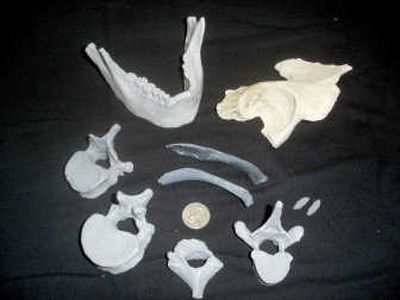Ancient remains return to tribes

ANCHORAGE, Alaska – Human remains estimated to be more than 10,000 years old will be returned to southeast Alaska Tlingit tribes 11 years after they were found in a cave in the Tongass National Forest.
It’s the first time a federal agency has conveyed custody of such ancient remains to indigenous groups under the 1990 Native American Graves Protection and Repatriation Act, U.S. Forest Service officials said Friday.
“It’s a pretty substantial find,” said Tongass spokesman Phil Sammon.
Vertebrae, ribs, teeth, a mandible and a pelvic bone were among the remains discovered in 1996 during a Forest Service archaeological survey for a proposed timber sale on northern Prince of Wales Island. The area is the aboriginal homeland for Tlingit tribes.
Stone tools also were found inside On Your Knees Cave, an extensive limestone network.
The Forest Service immediately consulted with area tribes as required by the repatriation law, which mandates that federal agencies, and institutions receiving federal money, return American Indian remains and cultural items to tribes.
There was never any dispute that the remains should go to Tlingit tribes in Craig and Klawock, communities on the island. The tribes and Sealaska Corp. – the southeast Alaska Native regional corporation – in February petitioned the agency for custody of the remains.
This came after a lengthy process including scientific analysis that determined the remains were 10,300 years old. Through DNA and other testing, researchers identified the remains as belonging to an indigenous man in his early 20s who subsisted primarily on seafood.
Some tribal members initially balked at allowing the studies to be done instead of immediate interment. But in the end they backed a study after determining the remains were scattered in the cave – possibly by scavengers – and not taken from a burial site.
In the remains, the tribes saw an ancestor offering himself for knowledge and learning, said anthropologist Rosita Worl, president of Sealaska Heritage Institute, the nonprofit cultural and educational arm of the Native corporation.
“The elders also saw it as a way of validating our ancient presence here in southeast Alaska,” said Worl, a Tlingit. “A number of elders have said it proves we’ve been here since time immemorial.”
The tribes will file a separate claim for the stone tools, which are from a different period, Worl said. The artifacts are made of obsidian, or volcanic glass, not naturally found in the area, which suggests early residents used boats to get around the coastal region.
The find also could support a theory that people migrated from Asia, as well as oral Tlingit histories about coastal migrations, according to Worl.
“We’re very, very excited and very proud of our people,” she said.
Finding remains that old is uncommon but not unheard of, said Sherry Hutt, repatriation program manager for the National Park Service. What stood out about the Tlingit case, she said, is the level of cooperation involved.
“The Forest Service went through the process carefully and methodically. It consulted with the locals and came to a decision based on analysis of the facts,” she said. “The process of consultation enhances the body of knowledge. This is a good example of it.”
Worl said she was happy the outcome was sharply different from the Kennewick Man, a 9,000-year-old skeleton found near the Columbia River in Washington the same year as the Tlingit remains. Disputes over the Kennewick Man have pitted archeologists against Indian tribes in the Northwest.
“I think ours is a really good example of what can be accomplished when scientists and federal agencies recognize the legal rights of Native people,” Worl said. “They’re professional with them. They’re sensitive with them. They’re equal with them.”
The remains are being held by the Forest Service while the tribes plan a ceremonial burial at the discovery site.